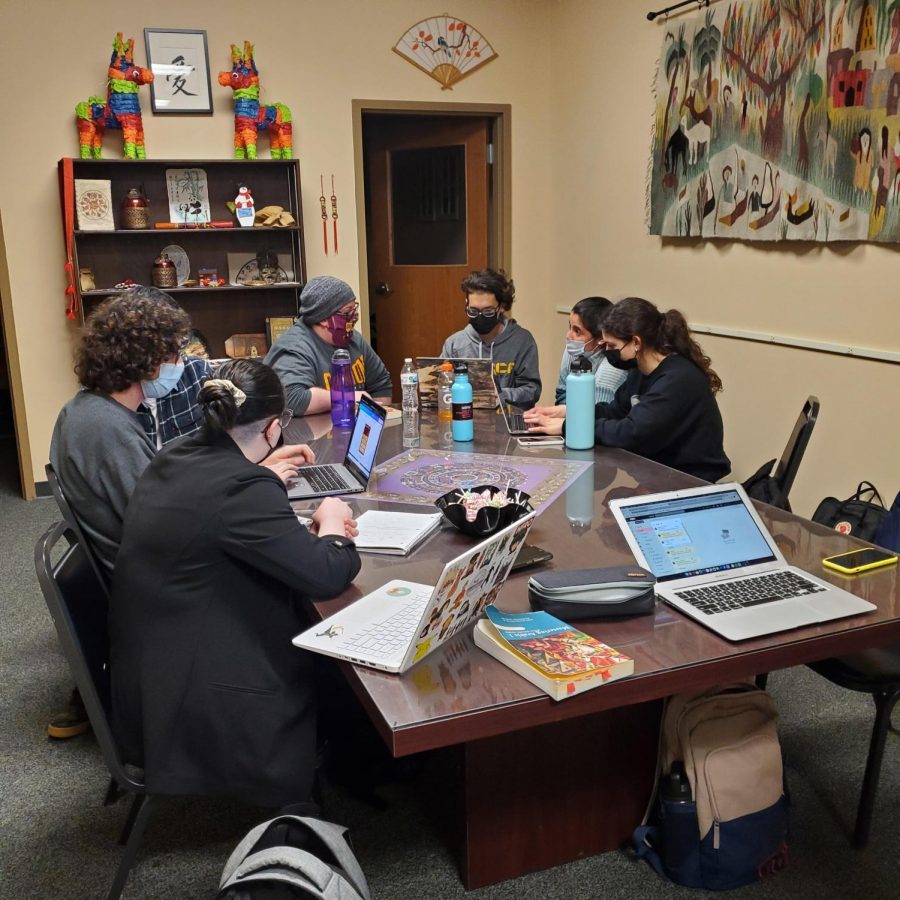Students and staff call for multilingual signage
CHESS Speaker Series discusses importance of accessibility
In response to discussion facilitated by the CHESS Speaker Series, a group of students and faculty set out to help Gannon and Erie meet the need for accessible, multilingual signage. This begins by recognizing the many global students on Gannon’s campus.
March 9, 2022
Walking across Gannon University, it’s hard to miss the signs denoting the buildings and landmarks that make up the campus. The names of buildings are emblazoned across the sides of them – Waldron Campus Center, Nash Library, Zurn Science Center and more can be found with ease due to the size of each sign.
Electronic kiosks are scattered along the main walkway through campus with rotating images telling the community of events, important dates, directions and campus news. Yard signs sometime line AJ’s Way, encouraging students, faculty and staff to keep wearing masks or advertising a campus blood drive or important event.
These and many more forms of signage can be seen across campus, and they have one thing in common: they’re all in English.
This underscores the need for multilingual signage, a focus of several events held at Gannon during the spring semester.
As part of the Reinventing Right Now CHESS Speaker Series, two events were held on campus to bring awareness to the need for multilingual signage both in Erie and on Gannon’s campus.
The first, a Feb. 8 talk with Penn State Behrend English professor Ashley Yochim, Ph.D., discussed the need for multilingual signage in Erie. The second, a multilingual signage workshop held Feb. 22, involved Gannon students and faculty designing multilingual sign prototypes for possible use on campus.
Because of the large population of global students at Gannon, the implementation of multilingual signage is important, said Martha Kosir, Ph.D., director of Gannon’s foreign languages program.
“The idea of multilingual signage would create a more welcoming place for our global students on campus itself, as well as for the refugee community in Erie,” she said. “Not only is it for those welcoming purposes, but it is for practical purposes, because there is a need for this kind of signage.”
According to an article Yochim wrote in 2016, all official government signs in Erie are written in Standard American English (SAE), which “reflects the point that SAE is the de facto, or unofficial but commonly practiced, national language in the U.S.,” Yochim said in her article.
According to Jem Neumann, a sophomore public service and global affairs and political science major, the de facto nature of English as the “official” yet unofficial language of the United States presents issues.
“The United States has never had an official language,” he said. “However, it is hard to remember this fact when so much of our culture is based on the English language and one’s understanding of it.”
Yochim also found in her research that a small number of non-English signs exist in the Erie area, and that most non-English signs are handwritten for businesses run by non-English speakers or signs with the names of the businesses on them.
Today, in the City of Erie there are 52 different countries of origin for refugees. According to Christopher Magno, Ph.D., an associate professor and chairperson of the criminal justice program at Gannon, the top eight countries of origin are Bhutan, Iraq, Burma, Ethiopia, Ukraine, Congo, Nepal and Sudan. Thus, the need for signage in the languages of these countries and others is necessary both in Erie and on Gannon’s campus.
“Erie is one of the most diverse places in this region,” Carolyn Baugh, Ph.D., an associate professor of history and foreign languages at Gannon, said. “Facilitating life for new Americans should be everyone’s priority.
“Imagine coming to Erie and needing a bus to get to work but being unable to really understand a bus schedule or even the process for boarding a bus and paying fare. Why can’t we have bus stops that have a multilingual guide to riding the bus? Why can’t we have multilingual recordings on our buses telling people what stop is coming?”
According to Baugh, during her talk Yochim pointed out to Gannon students and faculty that highway signs assume most people understand abbreviations and specific terms that new immigrants may not understand.
This unawareness extends to those within the Gannon community, who might not be aware of how limiting using exclusively English signage, even for things like mental health initiatives or on-campus activities, can be.
Through Yochim’s research and her talk at Gannon, Kosir said a group of Gannon faculty and students better understood the need for multilingual signage and set out to meet that need.
“We decided to start with campus just to see how this could benefit students here, and it’s basically a project that could become much larger in scope,” she said.
“There is definitely a need that most people don’t realize. That’s what we’re trying to change, but first, we’re trying to recognize our global students and create a more welcoming environment on campus.”
To Magno, starting this initiative at Gannon will hopefully spread to the greater Erie community, as there is currently no collective effort to incorporate multilingual signage in Erie other than those signs posted by individual businesses.
“Most Gannon initiatives are contagious,” he said. “When Gannon started Our West Bayfront, the effort immediately spread throughout the city, and the City of Erie and Erie Downtown Development Corporation followed through Gannon’s initiative. I think this will happen the same way with this newest project of installing multilingual signage on campus.”
Gannon global students, as well as students in upper-level Spanish and Arabic courses, worked together in the multilingual signage workshop held Feb. 22. During this workshop, they began the process of implementing multilingual signage on Gannon’s campus by creating prototypes.
For Josh Perrin, a junior criminal justice major, the workshop was an opportunity gain awareness about the barriers presented by a lack of multilingual signage.
“I learned about the difficulties of navigating campus for international students, concerning basic needs,” he said. “Getting food, finding the right buildings around campus, safety and community can all be difficult due to the language barrier that arises.”
Ren Reigel, a junior political science and philosophy major, said that the workshop expanded participants’ knowledge not only of the need for multilingual signage on Gannon’s campus but in the greater Erie area, as well.
“I learned that there really is a need for this signage from our international and newcomer student base,” they said. “I knew of Erie’s history as a refugee resettlement city, so I understood how our small project here on one of three university campuses in Erie could really start a bigger change that I think will catch on once we put in enough elbow grease.”
Reigel said students in the workshop spent hours designing signage on Canva, a free graphic design platform.
Baugh said that multilingual signage on Gannon’s campus extends beyond just official signage put up by the university. Students need to pitch in, too.
“It would be great if students, who are known to put up signs willy-nilly, would stop and think about how accessible their signs and posters are to non-native speakers,” she said. “What about a QR code that puts it in Spanish or Arabic?”
To Neumann, Gannon students can contribute to creating more accessible signage across campus in a multitude of ways.
“They can offer their knowledge of a different language, their artistic ability, their awareness of important locations and even put up signs around campus,” he said. “They can help raise awareness or funds for more signage on campus, or they can help anyone who comes up to them asking for assistance.
“There’s a lot of work to be done with this, a lot of skills are needed and there’s a place for everyone to help out.”
For Kosir, multilingual signage not only helps non-native English speakers but the community as a whole, as well.
“We hope to strike some curiosity about what the languages are and help people want to learn more about what is behind them,” she said. “Behind language there is culture, and the cultural richness is so important, not just for understanding the world but also for understanding ourselves.”
The prototypes designed by students and faculty during last month’s multilingual signage workshop are set to be on display from 3 p.m. until 5 p.m. Tuesday in Room 2206 of the Palumbo Academic Center. This multilingual signage exhibition is open to the Gannon community.
For more information on the Exhibition of Multilingual Signage, visit EngageU.
MADELINE BRUCE






Carolyn Cartwright • Mar 12, 2022 at 6:11 am
Great idea! I have also been thinking that it would be great for HR to have a Welcoming sign in multiple languages as well for both international students and faculty. Sign us up Please!